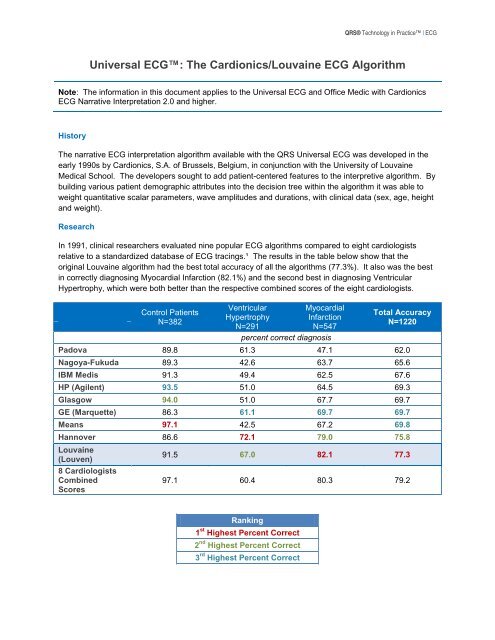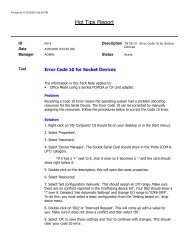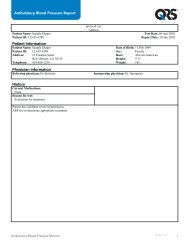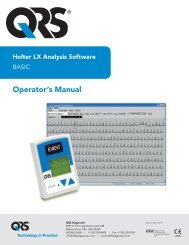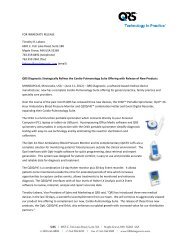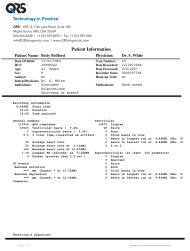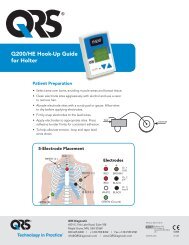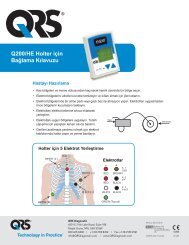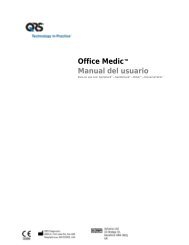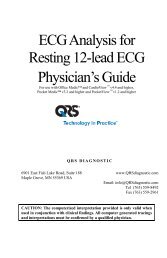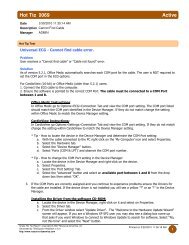Universal ECG Algorithm - QRS Diagnostic
Universal ECG Algorithm - QRS Diagnostic
Universal ECG Algorithm - QRS Diagnostic
- No tags were found...
Create successful ePaper yourself
Turn your PDF publications into a flip-book with our unique Google optimized e-Paper software.
<strong>QRS</strong>® Technology in Practice | <strong>ECG</strong><strong>Universal</strong> <strong>ECG</strong>: The Cardionics/Louvaine <strong>ECG</strong> <strong>Algorithm</strong>Note: The information in this document applies to the <strong>Universal</strong> <strong>ECG</strong> and Office Medic with Cardionics<strong>ECG</strong> Narrative Interpretation 2.0 and higher.HistoryThe narrative <strong>ECG</strong> interpretation algorithm available with the <strong>QRS</strong> <strong>Universal</strong> <strong>ECG</strong> was developed in theearly 1990s by Cardionics, S.A. of Brussels, Belgium, in conjunction with the University of LouvaineMedical School. The developers sought to add patient-centered features to the interpretive algorithm. Bybuilding various patient demographic attributes into the decision tree within the algorithm it was able toweight quantitative scalar parameters, wave amplitudes and durations, with clinical data (sex, age, heightand weight).ResearchIn 1991, clinical researchers evaluated nine popular <strong>ECG</strong> algorithms compared to eight cardiologistsrelative to a standardized database of <strong>ECG</strong> tracings.¹ The results in the table below show that theoriginal Louvaine algorithm had the best total accuracy of all the algorithms (77.3%). It also was the bestin correctly diagnosing Myocardial Infarction (82.1%) and the second best in diagnosing VentricularHypertrophy, which were both better than the respective combined scores of the eight cardiologists.Control PatientsN=382VentricularHypertrophyN=291MyocardialInfarctionN=547Total AccuracyN=1220percent correct diagnosisPadova 89.8 61.3 47.1 62.0Nagoya-Fukuda 89.3 42.6 63.7 65.6IBM Medis 91.3 49.4 62.5 67.6HP (Agilent) 93.5 51.0 64.5 69.3Glasgow 94.0 51.0 67.7 69.7GE (Marquette) 86.3 61.1 69.7 69.7Means 97.1 42.5 67.2 69.8Hannover 86.6 72.1 79.0 75.8Louvaine(Louven)91.5 67.0 82.1 77.38 CardiologistsCombinedScores97.1 60.4 80.3 79.2Ranking1 st Highest Percent Correct2 nd Highest Percent Correct3 rd Highest Percent Correct
<strong>QRS</strong>® Technology in Practice | <strong>ECG</strong>Peer Review of the Cardionics ProgramIn 1994, clinical researchers evaluated the New Cardionics algorithm using the same methodology as theclinical study above.² The following results were compared to the other eleven programs tested(Louvaine VCG, Marquette <strong>ECG</strong>, Hewlett-Packard <strong>ECG</strong>, Medis IBM <strong>ECG</strong>, Nagoya-Fukuda <strong>ECG</strong>, LyonVCG, Glassgow <strong>ECG</strong>, Porto VCG, Padova <strong>ECG</strong>, Means VCG and Means <strong>ECG</strong>). The New Cardionicsprogram had:• The highest score of total and partial accuracy at 73%.• The second highest rating for distinguishing between normal and abnormal patients 94.8%.• The highest sensitivity to AMI (Anterior Myocardial Infarction) at 81.8% with only 3.6% falsepositives for non-AMI cases.• The second highest sensitivity to detection of IMI (Inferior Myocardial Infarction at 73.4%.¹Willems, J.L., et al., “The <strong>Diagnostic</strong> Performance of Computer Programs for the Interpretation ofElectrocardiograms”, New England Journal of Medicine (1991); 325:1767-1773.²Li, G.P., et al., “The New Cardionics <strong>ECG</strong> Program and Its Comparison with Other Programs”,Japanese Heart Journal (1994); 35 (Supplement):257-258.6901 E. Fish Lake Road, Suite 188, Maple Grove MN 55369+1.800.465.8408 | +1.763.559.8492 | fax +1.763.559.2961info@<strong>QRS</strong>diagnostic.com | www.<strong>QRS</strong>diagnostic.comML935 07/12


